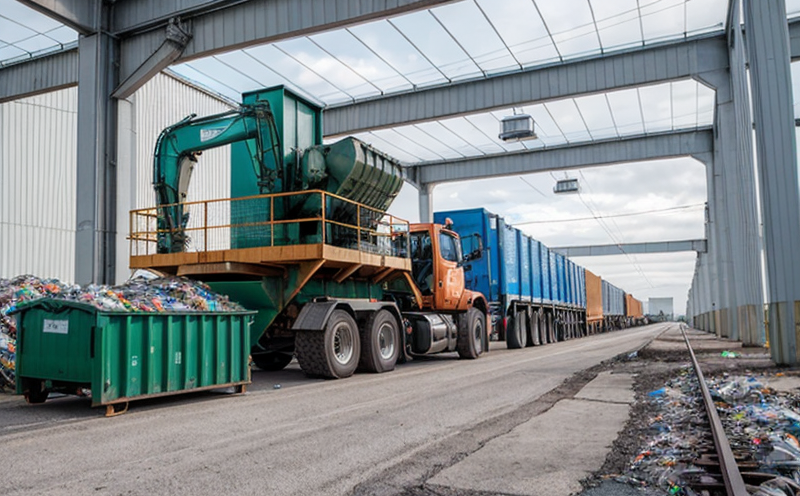ASTM D8172 Construction Waste Recycling Testing
The ASTM D8172 standard provides a comprehensive framework for evaluating the quality of recycled aggregates produced from construction waste. This test is particularly relevant in the industrial manufacturing sector where sustainable practices are becoming increasingly important. By ensuring that recycled materials meet certain criteria, this testing method supports the circular economy by promoting resource efficiency and reducing landfill waste.
The primary goal of ASTM D8172 is to standardize the process of assessing whether recycled aggregates can be used in new construction projects without compromising quality or safety standards. This test plays a crucial role in ensuring that reclaimed materials are suitable for reuse, thereby fostering environmental sustainability within industrial manufacturing processes.
Under this standard, samples of recycled aggregates undergo various analyses including particle size distribution, gradation, organic matter content, and strength properties among others. These tests help determine if the recycled material can be used as a substitute for virgin aggregate in construction applications such as concrete batching or road base courses.
The ASTM D8172 protocol ensures that reclaimed materials are not only durable but also meet all necessary specifications required by contemporary building codes and regulations. This standardization process is essential because it allows manufacturers to confidently use recycled aggregates while maintaining compliance with industry standards and ensuring product integrity.
| Test Parameter | Description |
|---|---|
| Particle Size Distribution | Determines the proportion of each size category within a sample, which affects how well the material mixes with other components during production. |
| Gradation | Refers to the continuous range of particle sizes present in aggregate materials; this impacts both workability and strength. |
| Organic Matter Content | Metric for measuring how much plant residue remains after processing, which could affect chemical stability over time if not controlled properly. |
| Strength Properties | Measures compressive or tensile strength to ensure the recycled aggregate can withstand typical stresses encountered in construction applications. |
The results from these tests are critical for quality assurance purposes, enabling manufacturers and contractors alike to verify that reclaimed materials meet stringent requirements set forth by ASTM D8172. Compliance with this standard not only enhances the reputation of companies involved but also contributes significantly towards achieving broader sustainability goals within industrial manufacturing.
Scope and Methodology
The scope of ASTM D8172 Construction Waste Recycling Testing encompasses multiple aspects aimed at validating the suitability of recycled aggregates for reuse in construction projects. This includes evaluating several key parameters such as particle size distribution, gradation, organic matter content, and strength properties.
| Parameter | Description | Methodology |
|---|---|---|
| Particle Size Distribution | Determines the proportion of each size category within a sample. | Samples are sieved using standard sieves to separate particles into different size fractions. The mass retained on and passing through each sieve is then measured. |
| Gradation | Refers to the continuous range of particle sizes present in aggregate materials. | The cumulative percentage retained on a series of standard sieves provides information about the gradation curve. This helps assess whether the recycled material can be effectively blended with other aggregates during batching processes. |
| Organic Matter Content | Metric for measuring how much plant residue remains after processing. | A combustion method using an organic matter analyzer is typically employed to quantify the amount of volatile solids present in the sample. This ensures that excessive levels do not interfere with performance characteristics like strength or durability. |
| Strength Properties | Measures compressive or tensile strength to ensure the recycled aggregate can withstand typical stresses encountered in construction applications. | Standard test methods such as slump tests for fluidity and unconfined compression testing for bulk density are used. These tests simulate real-world conditions under which the material will be utilized, providing valuable insights into its expected behavior during use. |
In order to conduct these tests accurately, it is important to follow strict procedures outlined in ASTM D8172. Proper sample preparation and handling are crucial steps that must be adhered to throughout the entire process from collection through analysis. Ensuring consistency across all stages helps maintain accurate results which ultimately contribute to reliable outcomes when determining whether recycled aggregates meet required standards.
Why Choose This Test
Selecting ASTM D8172 Construction Waste Recycling Testing offers several advantages for industrial manufacturers and processors looking to incorporate sustainable practices into their operations. One significant benefit is the ability to verify that reclaimed materials are suitable substitutes for virgin aggregates in various construction applications.
- Environmental Sustainability: By reusing recycled aggregates instead of disposing them in landfills, companies can significantly reduce waste generation and lower carbon footprints associated with raw material extraction.
- Cost Efficiency: Utilizing secondary resources like recycled materials reduces reliance on expensive primary inputs, leading to cost savings for businesses involved in the construction industry.
- Regulatory Compliance: Adherence to recognized standards such as ASTM D8172 ensures that products meet stringent quality and safety requirements set forth by relevant authorities. This fosters trust among customers who value responsible environmental stewardship.
- Innovation Opportunities: Engaging in research around optimizing recycling methods can lead to novel solutions that improve overall efficiency while maintaining high performance standards.
Furthermore, participating in ASTM D8172 Testing helps establish credibility and reputation for companies committed to eco-friendly initiatives. It demonstrates a commitment to innovation by exploring new ways of managing resources sustainably within industrial manufacturing processes.





